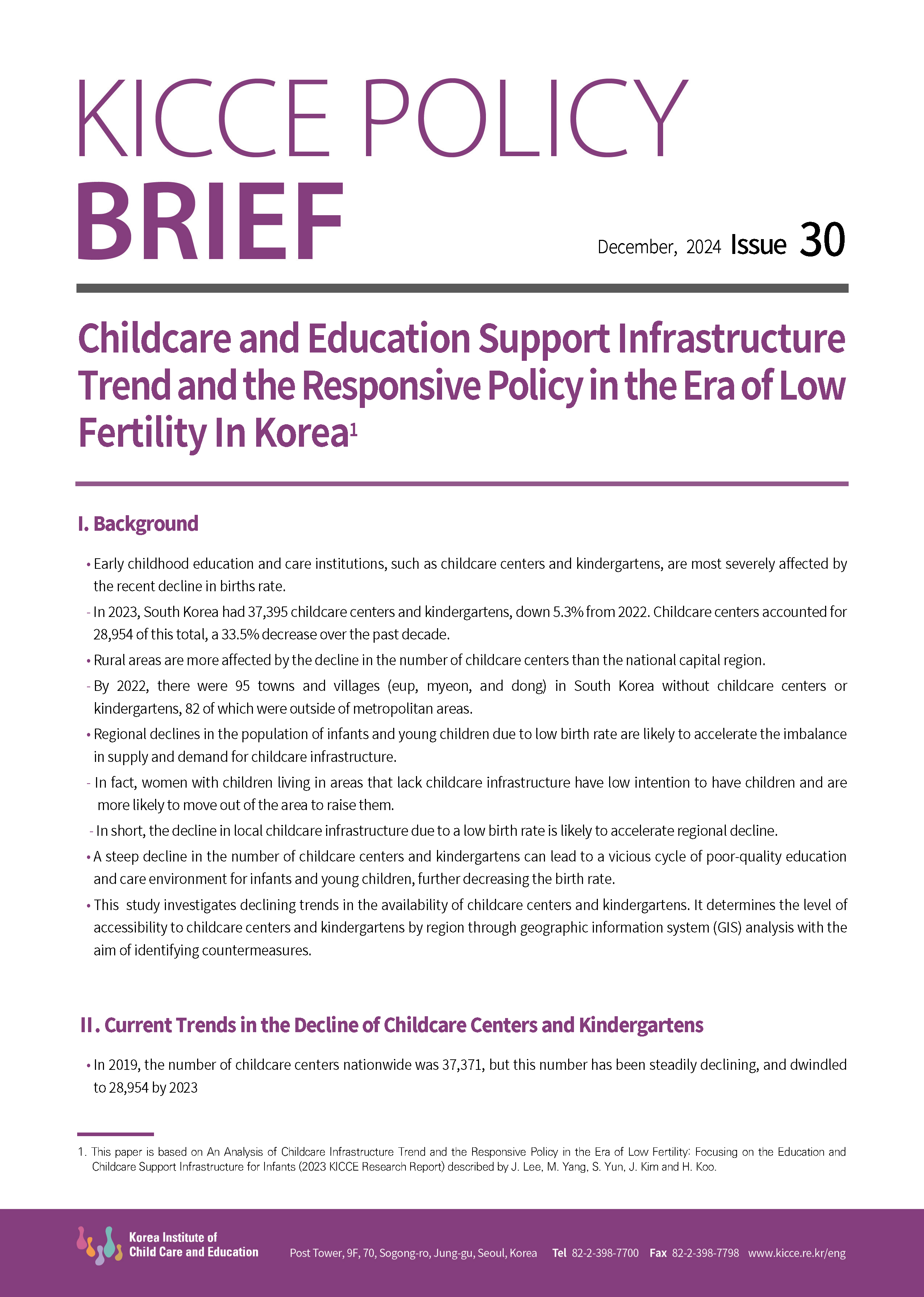- Publications
- Periodical
- KICCE Policy Brief
KICCE Policy Brief
KICCE Policy Brief
[Issue 30] Childcare and Education Support Infrastructure Trend and the Responsive Policy in the Era of Low Fertility In Korea
LIST
Ⅱ. Current Trends in the Decline of Childcare Centers and Kindergartens
Ⅲ. Analysis of accessibility to childcare centers and kindergartens
Ⅳ. Policy Suggestions
CONTENT
·Early childhood education and care institutions, such as childcare centers and kindergartens, are most severely affected by the recent decline in births rate.
·Rural areas are more affected by the decline in the number of childcare centers than the national capital region.
·Regional declines in the population of infants and young children due to low birth rate are likely to accelerate the imbalance in supply and demand for childcare infrastructure.
·A steep decline in the number of childcare centers and kindergartens can lead to a vicious cycle of poor-quality education and care environment for infants and young children, further decreasing the birth rate.
·This study investigates declining trends in the availability of childcare centers and kindergartens. It determines the level of accessibility to childcare centers and kindergartens by region through geographic information system (GIS) analysis with the aim of identifying countermeasures.
·In 2019, the number of childcare centers nationwide was 37,371, but this number has been steadily declining, and dwindled to 28,954 by 2023.
·The largest decrease in the number of childcare centers occurred in Gyeongnam (31.4%), followed by the Gyeongbuk (29.0%), Daejeon (28.9%), and Jeonbuk (26.7%).
·Over the past five years, the number of national and public childcare centers has increased by 43.1%, while home-based childcare centers have decreased by 37.5% and private childcare centers by 29.3%, according to data on childcare centers by establishment type.
·The number of kindergartens across the country has steadily decreased since 2019 from 8,837 to 8,441 by 2023, a decrease of approximately 4.5%.
·The largest decrease in the number of kindergartens by city/province was in Daegu(9.3%), followed by Gwangju (8.3%) and Seoul (7.3%).
·In Sejong, the number of kindergartens increased by 8.3%.
·By establishment type, the number of private kindergartens decreased by 16.8%, whereas that of national and public kindergartens increased by 5.6%.
·A GIS analysis was conducted to determine the distance between infants and young children attending childcare centers and kindergartens.
·Based on a walking distance of 600 meters as the threshold for access to childcare centers for infants (0– to 2-year-olds), the percentages of infants living within the service area are 63% at the national level, 91% at the dong level, and 22% at the eup/myun level.
·Based on a driving distance of 6 kilometers as the threshold, the percentages of infants (0– to 2-year-olds) living within the service area are 85% at the national level, 100% at the dong level, and 64% at the eup/myun level.
·Based on a walking distance of 600 meters as the threshold for access to childcare institutions for young children (3– to 5-year-olds), the percentages of young children living within the service area are 64% at the national level, 89% at the dong level, and 27% at the eup/myun level.
·Based on a driving distance of 6 kilometers as the threshold, the percentages of young children (3– to 5-year-olds) living within the service area are 93% at the national level, 100% at the dong level, and 83% at the eup/myun level.
·Selecting vulnerable areas based on scientific methods
·Strengthening infrastructure support for childcare centers and kindergartens in vulnerable areas
·Establishing shared programs for small childcare centers and kindergartens
·Launching the “visiting childcare teacher” project
- PREV
- [Issue 29] The Current Status and Perspectives on Infant Abuse in South Korea
- 주송희
- 2024.12.09
- NEXT
- No next article.

